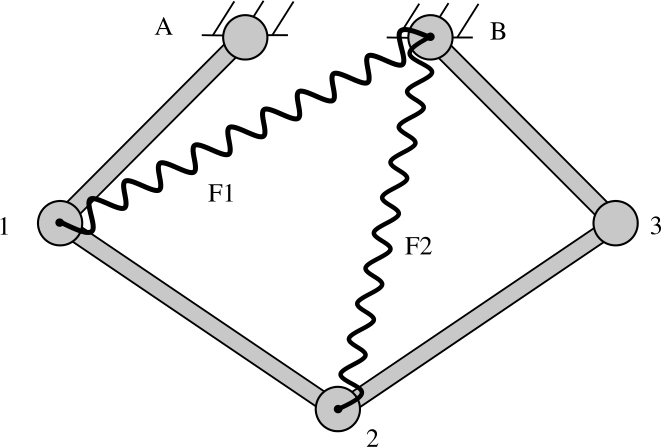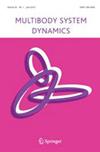带投影的增广拉格朗日指数-3半递推公式
IF 2.4
2区 工程技术
Q2 MECHANICS
引用次数: 0
摘要
灵敏度分析是多体系统动力学优化的有力工具。基于梯度的优化算法的性能与所考虑的动态和灵敏度公式密切相关。精度和效率对任何优化问题都至关重要,因此它们是选择用于计算目标函数梯度的动态分析方法和灵敏度分析方法的关键因素。半递归方法在计算时间方面通常优于全局方法,尽管它们有时涉及要求很高的递归过程。半递归方法具有鲁棒性、约束方程的精确实现和计算量小等优点,适合与不同的约束执行方案相结合,如带速度和加速度投影的增广拉格朗日指数-3公式(ALI3-P)。本文用直接微分法研究了半递推ALI3-P公式的灵敏度分析。在此基础上,建立了任意参考点选择的半递归ALI3-P灵敏度公式,并在通用多体库MBSLIM中展开和实现了两个特定版本,分别以质心(RTdyn0)或坐标全局原点(RTdyn1)作为参考点。此外,还给出了递归项的详细导数,这不仅适用于本文提出的直接灵敏度公式,也适用于依赖相同递归表达式的其他灵敏度公式。该实现已在两个数值实验、一个五杆基准问题和一辆小车中进行了测试。本文章由计算机程序翻译,如有差异,请以英文原文为准。

Augmented Lagrangian index-3 semi-recursive formulations with projections
Abstract Sensitivity analysis represents a powerful tool for the optimization of multibody system dynamics. The performance of a gradient-based optimization algorithm is strongly tied to the dynamic and the sensitivity formulations considered. The accuracy and efficiency are critical to any optimization problem, thus they are key factors in the selection of the dynamic and sensitivity analysis approaches used to compute an objective function gradient. Semi-recursive methods usually outperform global methods in terms of computational time, even though they involve sometimes demanding recursive procedures. Semi-recursive methods are well suited to be combined with different constraints enforcement schemes as the augmented Lagrangian index-3 formulation with velocity and acceleration projections (ALI3-P), taking advantage of the robustness, accurate fulfillment of constraint equations and the low computational burden. The sensitivity analysis of the semi-recursive ALI3-P formulation is studied in this document by means of the direct differentiation method. As a result, a semi-recursive ALI3-P sensitivity formulation is developed for an arbitrary reference point selection, and then two particular versions are unfolded and implemented in the general purpose multibody library MBSLIM, using as reference point the center of mass (RTdyn0) or the global origin of coordinates (RTdyn1). Besides, the detailed derivatives of the recursive terms are provided, which will be useful not only for the direct sensitivity formulation presented herein, but also for other sensitivity formulations relying on the same recursive expressions. The implementation has been tested in two numerical experiments, a five-bar benchmark problem and a buggy vehicle.
求助全文
通过发布文献求助,成功后即可免费获取论文全文。
去求助
来源期刊
CiteScore
6.00
自引率
17.60%
发文量
46
审稿时长
12 months
期刊介绍:
The journal Multibody System Dynamics treats theoretical and computational methods in rigid and flexible multibody systems, their application, and the experimental procedures used to validate the theoretical foundations.
The research reported addresses computational and experimental aspects and their application to classical and emerging fields in science and technology. Both development and application aspects of multibody dynamics are relevant, in particular in the fields of control, optimization, real-time simulation, parallel computation, workspace and path planning, reliability, and durability. The journal also publishes articles covering application fields such as vehicle dynamics, aerospace technology, robotics and mechatronics, machine dynamics, crashworthiness, biomechanics, artificial intelligence, and system identification if they involve or contribute to the field of Multibody System Dynamics.

 求助内容:
求助内容: 应助结果提醒方式:
应助结果提醒方式:


